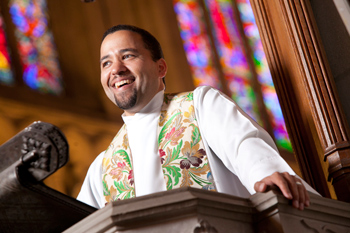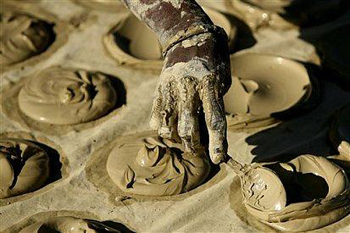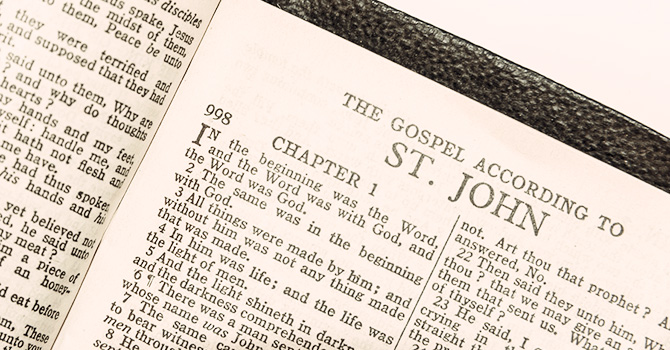Editor’s note: Faith & Leadership offers sermons that shed light on issues of Christian leadership. This sermon was preached April 11, 2010, at Westminster Presbyterian Church in Durham, N.C.
Psalm 118:14-29 ; John 20:19-31
Scar stories. I’m guessing everyone in this congregation has one, if not several. Our youth director, Rebecca, tells me that scar stories are a favorite “get-to-know-you” game with our youth. They can be great conversation starters. In fact, it was one of the first discussions Pastor Chris and I had when we initially met. We had similar small scars on our foreheads, and we immediately began comparing stories: mine from chickenpox at age 3, his from a tree branch at age 26.
There truly is a story behind every scar. Some of the stories are painful; others are funny. Some are significant, while others, less so. Some are filled with shame, while others are full of pride. Yet without exception, every scar serves as a visible reminder of wounds we’ve incurred.
Given this fact, the sermon title today, “Scars of Hope,” seems like an oxymoron. How can scars, formed only by pain, be full of hope? In our Christian faith, hope is symbolized by the death and resurrection of Jesus Christ. Many of us wear the cross as a sign of hope around our necks. Yet, as our young adult group discussed recently, the cross was really a symbol of torture during Roman times. Wearing a cross around your neck then would be like wearing an electric chair around your neck now. And who would do that? So how did this symbol of torture become a symbol of hope?
It was because Christ overcame the agonizing death of crucifixion by his resurrection. It is what we triumphantly celebrated here last Easter morning with the festive, meaningful music and the children proclaiming, “Christ is risen indeed!” And yet the scars of Jesus remind us that we cannot simply skip from the celebrations of Palm Sunday to Easter morning. The scars help us remember the dark days between the two and the suffering Jesus went through to justify our sins.
I can think of no better modern-day illustration of the sacrifice Jesus made for us than a recent scar story I heard from a tennis friend of mine. As we were waiting for another match to finish, she was relating how badly her knees hurt. This friend is the most fit 30-something-year-old I know. Yet she sat beside me with a brace on each knee. I pointed to the open hole of her knee brace and asked if her scar was from knee surgery. She told me, “No, it’s from my son, and I actually have an identical scar on my other knee.”
You see, several years ago she scooped up her toddler son from the swimming pool and began to walk towards a lounge chair. As she stepped onto the tiled patio, her foot slipped on the wet slick surface. She was also seven months pregnant, and it was one of those moments where you feel like you’re moving in slow motion but there’s nothing you can do to stop the fall. Within a split second, she knew her momentum was toppling her forward, and she could either face-plant and land on top of both her son and her unborn child, or she could fall on her knees.
Of course, as any loving parent would do, she chose to fall on her knees directly onto the unforgiving concrete. Her knees immediately burst open and blood went everywhere. She ended up needing stitches, which resulted in scars, but her son and unborn child were both unscathed. It is hard for me to tell this story without tearing up, because to me, it serves as a miniscule example of the immense sacrifice and love of Jesus Christ for us. You see, we are the beloved children of God for whom Jesus took the fall. Christ suffered on the cross and endured unimaginable pain for us. His is the greatest scar story ever told.
It is because of this amazingly painful sacrifice of Christ that when I’m serving communion, I request that the bread not be pre-cut. It’s not simply that I’m a picky, persnickety minister. There’s actually a theological reason behind the request. When the words of institution are proclaimed and the bread is broken, I don’t believe the bread should break in an effortless, neat, symmetrical way, because the cross was not simple and tidy. Friends, the cross was messy. Christ suffered tremendously. The bread should be hard to break. If the symbol of Christ’s body broken for us -- the breaking of the bread during communion -- looks too easy, then we might intuit that the cross was easy and that Christ bore no pain.
But the scars of Jesus tell us differently. They serve as visible reminders that in addition to being fully divine, Christ was indeed fully human as well. Jesus felt deep pain, and through his resulting scars and resurrection, we are able to feel deep redemption. We are able to feel hope and renewal. It seems that this is the predominant reason why Jesus wanted the disciples to see his wounds, so that they could understand the hope the scars represented.
As we heard in the New Testament passage read this morning, on the very evening of Christ’s glorious resurrection, our risen Lord appeared to the disciples, and after greeting them with peace, showed them his scars. Notice that before his appearance, the disciples were hunkered down in fear together, locked in a house. Yet once they saw the scars of Jesus, a transformation occurred, and they began to rejoice. How ironic that seeing scars, which were produced by pain, provided joy and hope.
It is here in this passage -- when Jesus shows his wounds to the disciples and then to Thomas a week later -- that we first glimpse why the scars of Jesus are so significant. What if Jesus had appeared to the disciples without scars? They would not have been able to trust that this man was truly their risen Lord, the one who died on the cross. No trace of scars on him would also have made them question if Jesus was fully human as well as fully divine. It would make us question if Christ truly understood the human pain and suffering we go through. The scars of Jesus -- the scars of hope -- are significant to our faith.
It is often thought that the disciples and Thomas -- who, by the way, has been mistakenly dubbed “doubting” all these years -- it is thought that they asked to see the wounds. But if you look closely at the text, you’ll see that it was Jesus who initially offered to show his scars to them. The disciples responded with joy, and likewise, Thomas replied with what many theologians describe as the central truth of this Gospel, as he declared, “My Lord and my God.” In this proclamation, Thomas uttered the most powerful confession of Jesus’ identity in the Gospel. When the resurrected Jesus showed Thomas his scars, Thomas recognized God fully revealed in Christ, the Word made flesh.
New Testament scholar and dean of Duke Divinity Richard Hays comments on this passage: “Isn’t it curious that God could raise Jesus from the dead but didn’t heal the nail wounds in his hands? Was this an oversight? Surely not. The power of death is conquered, but the [scars] remain.”[“Fingering the Evidence,” The Christian Century (April 1, 1992)]. When Jesus showed the disciples his scars, he was saying, “Here is my signature.”
Jesus, our Lord and our God in the glory of the resurrection, still bears the wounds of his experience of God with us on earth. The resurrection did not remove his human experience. The risen Lord still bears on his body the scars that speak of his solidarity with human suffering in all of its forms. These scars serve as a reminder that God is with us through all things, especially the appalling, destructive and death-dealing times.
The image of the risen Christ with wounds in his hands and his side reminds us when we suffer that so did our God; when we cry out in loneliness, so did our God. When we feel abandoned and alone, we remember that Christ hung on a cross and yelled for us, “My God, my God, why have you forsaken me?” We don’t have a God who stands at a distance but rather one who entered fully into the reality of our pain. So when we suffer, we know that Christ can say, “I’ve been there, and I have the wounds to prove it.”
Christ’s scars become part of our story, and our scars become a part of God’s story in our lives. The scars of Christ become scars of hope as we deal with our own wounds in life. It seems there are some scars we love to show off, and there are others we want sewed up as neat as possible so that no one ever knows. Yet scars, whether visible to the eye or not, are something we all have in common -- something everyone shares. We all have experienced pain, both physically and emotionally, in our lives. Yet we are so often reluctant to share them with one another.
My dear step-grandmother, who is nearly 90 years old, lives at a retirement and health center in Raleigh. She suffers from Alzheimer’s disease and recently fell and hit her head on the bathroom floor. As the aides came to help her, she touched the bloody wound on her head and said, “Oh dear, I simply cannot go to church looking like this.” Of course, it wasn’t even Sunday morning, but the first thing that came to her decaying mind was the age-old belief that you have to look perfect on the outside and inside to go to church.
I surely hope we don’t believe that here at Westminster. This is a loving, caring church, full of sinners. We’re all here because no one is perfect. All of you have seen the Stephen Minister cards that are in the pews that say, “I HURT! Does anyone care enough to listen?” In capital letters and underlined, it reads, “YES -- A Stephen Minister will be there for you.” And this is true. Stephen Ministers and Stephen Visitors are some of the best programs our church has to offer if you are hurting physically or emotionally. However, a few weeks ago, when I looked at one of those cards, under the question, “Does anyone care enough to listen?” I saw a “No” penciled in. It broke my heart, mainly because I knew that I was likely sitting within a five-foot radius of the person who wrote this. Not knowing who wrote it, I wanted to go up to everyone around me after church that day and say, “I care. Our whole staff cares. Other church members care. We’ll listen to you.”
And yet it’s hard to share. It’s hard to be vulnerable, and it’s hard to tell the bold truth about our lives and admit how we hurt. It’s uncomfortable and risky. And yet my hope is that we can begin to share our vulnerabilities with one another -- and that, in doing so, we can experience that same type of transformative moment -- the move from fear to joy -- that the disciples had when exposed to the scars of Jesus. Above all, I hope we can share with confidence and joyfully celebrate that Christ’s redemption is greater than any wound and able to heal any scar. Instead of hiding our scars, let us say, “Look and see where God has redeemed me.”
Let us never forget our Lord and our God, who took the fall for us, who suffered on the messy cross, who was crucified, died, and yet who rose again, the One who knows our pain, and whose scars are scars of hope for us.
In the name of the Father, Son and Holy Spirit, Amen.












